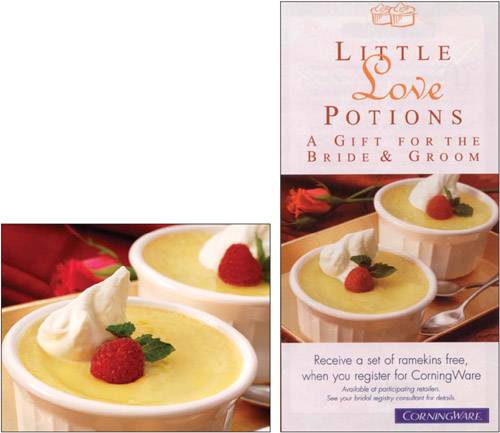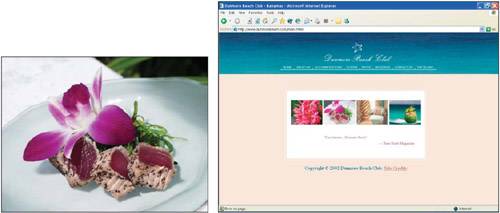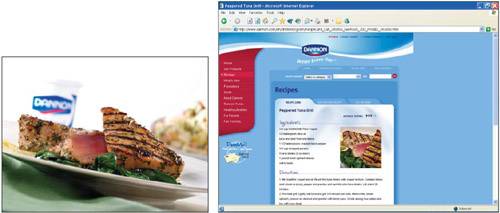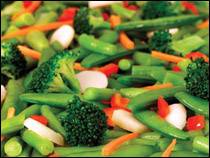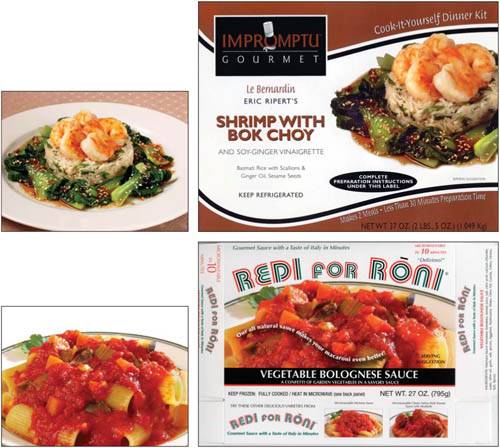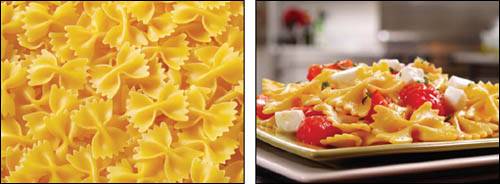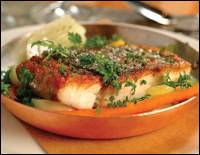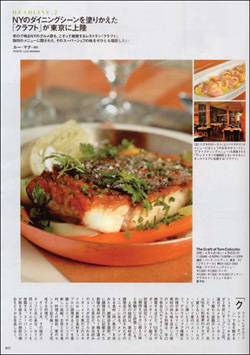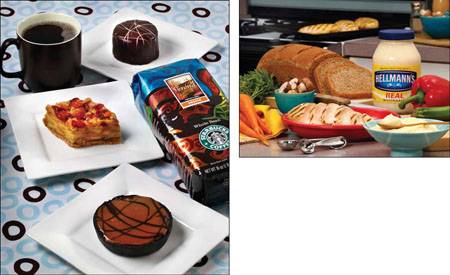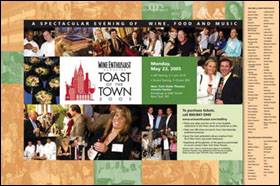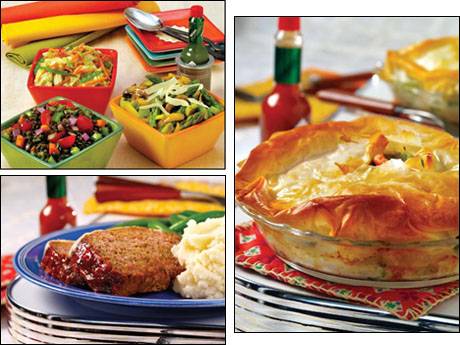Shooting for Advertising, Packaging, Media Usage, and Public Relations
| Important differences in the purposes and needs of advertising, packaging, media usage, and public relations dictate the approach you will take in your digital food photography. AdvertisingWhen taking photos that will be used in advertising, you aim for perfection in every aspect of the shot. Advertising pictures are designed to depict the product in an ideal state to entice people to buy a product. These pictures can be placed in a wide range of media, such as magazines, newspapers, TV, posters, and the Internet. These images also can be found in many other kinds of media, such as product brochures, restaurant menu boards, and retail point-of-purchase displays. Food manufacturers invest a great deal of money to generate customer loyalty and establish an emotional bond with the consumer. There is far less creative freedom in advertising photography than in shooting for media or public relations. Advertising photographs, as well as photos used for product packaging, must explicitly reflect the art director's vision and layout, without deviation. Art directors create the concept of the shoot, after which a photographer is selected and the creative process begins. Food and prop stylists create the perfect look that will grab the audience's attention. In especially large or high-budget projects, the stylists might in turn hire additional staff members. Advertising involves far more intense attention to every aspect of the food, props, and lighting than any other area of food photography, and is by far the most labor and time intensive. The art director and client are almost always present, and provide nearly continuous input and feedback during the shoot. The food stylist and prop stylist constantly adjust and fine tune the food and set to ensure perfection in every detail. Note Although advertisements must always show the real food, it can be tweaked and accentuated in appearance. Following are some specific examples of photographs used in advertising media. Magazine Ads 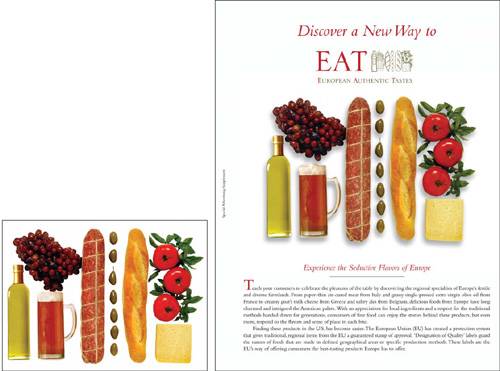 Table Tents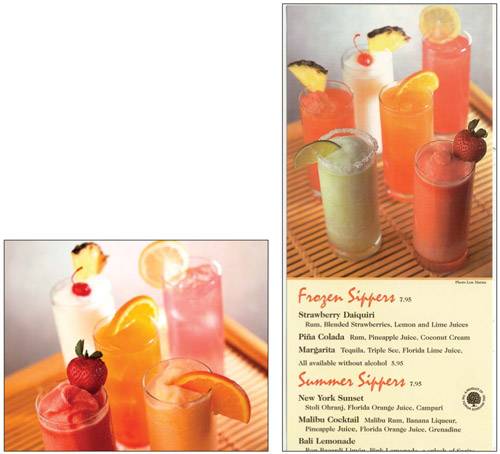  Restaurant Menu Boards Brochures Web Sites Product PackagingPackaging is designed to convey the "personality" of the brand, and food-product packaging is an art form unto itself. The package is what you face at the point of purchase. It is the hard sell. The image and brand awareness have to shine brightly. Imagery, color, logos, words, and graphics all work together to create a selling package. Note Photos on food packages have been steadily increasing in size to increase the "saliva factor" and grab the consumer's attention. Taking photographs for packaging requires strict adherence to a very precise layout, because space needs to be reserved for type and other graphics. When shooting for packaging, the contrast range is lower than normal in order to ensure that proper detail is maintained when the image is reproduced on a variety of surfaces, such as plastic, paper, or cardboard. Generally, the package photo is a close-up view of the product, and is in sharp focus. Props are kept to a bare minimum so attention is on the product itself, but sometimes a little garnishsuch as a sprig of parsley or fresh herbswill be added to give the product more appetite appeal. In addition, the food stylist always works from the actual product to bring out the best of what the consumer will find in the package. Often, the stylist will open many packages to find the best examples of the product, and then will carefully enhance and arrange the various elements so the food looks its best. Media UsagePhotos for glossy magazines or newspaper food sections are likely to have the appearance of "casual reality." Editorial content is used in conjunction with recipes and pictures to draw the audience into the experience of food. These photos generally portray food in a way that tries to make the reader feel, "That's something I'd like to try," or "I can make that." There is a comfort level and approachability factor in the image. Media usage is the area in which the photographer and stylists have the most creativity and freedom. Most of the time, there is minimal artistic direction from the client or art directors. The lighting contrast can be more pronounced, and there can be exaggerated shadows and more highlights on the food. In addition, soft-focus techniques and props can be used more liberally to create a mood. Because the photos often try to portray a sense of reality, we don't hesitate to allow imperfections in the food to show. The following are some examples of foods used in magazines and newspapers. Magazines Food Photography is a universal language. Newspapers Industry PublicationsIn contrast, photos that are intended for use in industry publications might be simple, straightforward shots that can be used to introduce a new or improved product, packaging, or design to people in the trade. In these cases, your pictures are likely to have little or no embellishment, and prominently feature a bag, box, or label. Usually, prop stylists are not involved in these shoots because the product is shot against a plain or white background. Public RelationsWhile food advertisers know that their pictures will be used exactly as they intendbecause they buy and control the space in which their ads will runin public relations there is little or no control over how pictures will be edited or used, if at all. In photographs for public-relations use, where it is up to an editor to decide whether to use the picture in a news context, the product often needs to take a back seat to some other aspect of the picture. When I take pictures for public-relations clients, I keep the lighting simple and clean. I have a lot of freedom in arrangement and composition, keeping in mind that a natural, less staged-looking picture usually has the best chance of being used by journalists and editors. Sometimes, PR photos are distributed to the media as part of a new product launchfor example, a new line of Starbucks baked goods. Other times, the photos might be used to illustrate a general lifestyle message, such as Hellman's campaign to position its product as a viable, delicious ingredient for preparing foods. Often, in addition to publicity shots, pictures that are taken for PR campaigns communicate something newsworthy about a product or an event to which it is connected. Event photos might include company executives, celebrities, or the public. Over the years, I have photographed numerous events such as the Wine Enthusiast Magazine Toast of the Town event, Taste of New York, the European Wine Council Gala, the Gingerbread on Broadway competition at the Marriott Marquis hotel, and the James Beard Awards. When shooting at events, I use portable flash equipment on a bracket powered by an external battery pack. This gives me the freedom to move around unencumbered by wires and cables. Don't use a camera's built-in flash for this kind of workit is not powerful enough to light the subject properly, it does not recycle quickly enough to take multiple shots in succession, and it can cause red eye, which needs to be retouched in post-production. You want to be able to turn these pictures around very quicklythe newsworthiness of the event is short and clients want to be able to have the final images right away. Tip Placing the external flash on a bracket, or hand-holding it away from the camera, eliminates the chance of red eye and gives more depth to the photograph. I typically use a second flash that I trigger with a PocketWizardPlus radio transmitter. The second flash is on a tall stand with wheels off to the side, so I can move it easily. The PR photographer's challenge is to capture an image that can fit seamlessly into many media outlets' editorial and graphic styles without appearing to be promotional. In many cases, the product can be shown only subtly, and the label or brand might have to be hidden or kept in the background. While the long-term goal of a PR campaign is to create a "buzz" and make audiences feel good about a product or the companyand ultimately increase salesthe short-term strategy usually is to downplay overt commercial messages. |


